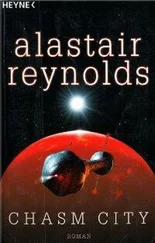Reynolds, Alastair - Redemption Ark
Здесь есть возможность читать онлайн «Reynolds, Alastair - Redemption Ark» весь текст электронной книги совершенно бесплатно (целиком полную версию без сокращений). В некоторых случаях можно слушать аудио, скачать через торрент в формате fb2 и присутствует краткое содержание. Жанр: Старинная литература, на английском языке. Описание произведения, (предисловие) а так же отзывы посетителей доступны на портале библиотеки ЛибКат.
- Название:Redemption Ark
- Автор:
- Жанр:
- Год:неизвестен
- ISBN:нет данных
- Рейтинг книги:3 / 5. Голосов: 1
-
Избранное:Добавить в избранное
- Отзывы:
-
Ваша оценка:
- 60
- 1
- 2
- 3
- 4
- 5
Redemption Ark: краткое содержание, описание и аннотация
Предлагаем к чтению аннотацию, описание, краткое содержание или предисловие (зависит от того, что написал сам автор книги «Redemption Ark»). Если вы не нашли необходимую информацию о книге — напишите в комментариях, мы постараемся отыскать её.
Redemption Ark — читать онлайн бесплатно полную книгу (весь текст) целиком
Ниже представлен текст книги, разбитый по страницам. Система сохранения места последней прочитанной страницы, позволяет с удобством читать онлайн бесплатно книгу «Redemption Ark», без необходимости каждый раз заново искать на чём Вы остановились. Поставьте закладку, и сможете в любой момент перейти на страницу, на которой закончили чтение.
Интервал:
Закладка:
But by then the humans had already been busy inside. They had cored out the comet, tamping eighty per cent of its interior volume into a thin, hard shell that was used to line the outer shell. The resultant chamber was fifteen kilometres wide and perfectly spherical. Concealed shafts permitted entry into the chamber from outside space, wide enough to accept a moderately large spacecraft provided the ship moved nimbly. Berthing and repair yards festered across the inner surface of the chamber like the dense grid of a cityscape, interrupted here and there by the cryo-arithmetic engines, squat black domes which studded the grid like volcanic cinder plugs. The huge engines were quantum refrigerators, sucking heat out of the local universe by computational cooling.
Clavain had made the entrance transition enough times not to be alarmed by the sudden whiplash course adjustments necessary to avoid collisions with the comet’s rotating husk. At least, that was what he told himself. But the truth was he never drew breath until he was safely inside or out. It was too much like diving through the narrowing gap in a lowering portcullis. And with a ship as large as Nightshade, the adjustments were even more brutal.
He entrusted the operation to Nightshade ’s computers. They knew exactly what needed to be done, and the insertion was precisely the kind of well-specified problem that computers handled better than people, even Conjoined people.
Then it was over, and he was in. Not for the first time, Clavain felt a dizzying sense of vertigo as the comet’s interior space came into view. The husk had not stayed hollow for long. Its cored-out volume was filled with moving machinery: a great nested clockwork of rushing circles, resembling nothing so much as a fantastically complex armillary sphere.
He was looking at the military stronghold of his people: the Mother Nest.
There were five layers to the Mother Nest. The outer four were all engineered to simulate gravity, in half-gee increments. Each layer consisted of three rings of nearly equal diameter, the plane of each ring tilted by sixty degrees from its neighbour. There were two nodes where the three rings passed close to each other, and at each of these nodes the rings vanished into a hexagonal structure. The nodal structures functioned both as an interchange between rings and a means of guiding them. Each ring slid through sleeves in the nodal structures, constrained by frictionless magnetic fields. The rings themselves were dark bands studded with myriad tiny windows and the occasional larger illuminated space.
The outermost triplet of rings was ten kilometres across and simulated gravity at two gees. One kilometre of empty space inwards, a smaller triplet of rings spun within the outermost shell, simulating gravity at one and a half gees. One kilometre in from that was the one-gee ring triplet, consisting of by far the thickest and most densely populated set of rings, where the majority of the Conjoiners spent the bulk of their time. Nestling within that was the half-gee triplet, which in turn encased a transparent central sphere that did not rotate. That was the null-gee core, a pressurised bubble three kilometres wide stuffed with greenery, sunlamps and various microhabitat niches. It was where children played and elderly Conjoiners came to die. It was also where Felka spent most of her time.
Nightshade decelerated and came to a stop relative to the outermost triplet. Already, servicing craft were emerging from the whirling rings. Clavain felt the jolts as the tugs latched on to Nightshade ’s hull. When he had disembarked, his vessel would be hauled towards the shipyards quilting the chamber’s wall. There were many ships already berthed there: various elongated black shapes hooked into a labyrinth of support machines and repair systems. Most were smaller than Clavain’s ship, however, and there were no genuinely large vessels.
Clavain left the ship with his usual slight feeling of unease, of a job not properly finished. It had been many years before he realised quite what caused this: it was the way that his fellow Conjoiners said nothing to each other as they left the craft, despite the fact that they might have spent months together on a mission, and encountered many risks.
A robot tender collected him from one of the hull airlocks. The tender was an upright box with generous windows, squatting on a rectangular base studded with rockets and impeller fans. Clavain boarded it, watching a larger tender depart from the next airlock along. In the other tender he saw Remontoire with two other Conjoiners and the prisoner they had captured on the Demarchist ship. From a distance, the pig, slouched and docile, could easily have been mistaken for a human prisoner. For a moment Clavain thought that the pig was being pleasingly co-operative, until he recognised the glint of a pacification coronet wrapped around the prisoner’s scalp.
They had trawled the pig on the way back to the Mother Nest, but had learned nothing specific. The pig’s memories were highly blockaded; not in the Conjoiner fashion, but in the crude black-market style that was common amongst the Chasm City criminal underworld, and which was usually implemented to shield incriminating memories from the various branches of the Ferrisville constabulary: the sirens, scythes, skulltappers and eraserheads. With the kind of interrogation techniques that were possible in the Mother Nest, Clavain had no doubt that the blockades could be dismantled, but until then he could discover nothing other than that they had recovered a small-time pig criminal with violent tendencies, probably affiliated to one of the larger pig gangs operating in and around Yellowstone and the Rust Belt. Clearly the pig had been up to no good when he was captured by the Demarchists, but that was hardly unusual for pigs.
Clavain neither liked nor disliked hyperpigs. He had met enough to know that they were as morally complex as the humans they had been engineered to serve, and that every pig should be judged on its own terms. A pig from the Ganesh industrial moon had saved his life three times during the Shiva-Parvati cordon crisis of 2358. Twenty years later, on Irravel’s Moon, orbiting Fand, a group of pig brigands had taken eight of Clavain’s soldiers hostage and had then begun to eat them alive when they refused to divulge Conjoiner secrets. Only one Conjoiner had escaped, and Clavain had taken his pain-saturated memories as his own. He carried them now, locked away in the most secure kind of mental partition, so that they could not be unlocked accidentally. But even this had not made him hate pigs as a species.
He was not sure whether the same could be said for Remontoire. Deep in Remontoire’s past lay an even more horrific and protracted episode, when he had been taken prisoner by the pig pirate Run Seven. Run Seven had been one of the earliest hyperpigs, and his mind had been riddled with the psychotic scars of flawed neuro-genetic augmentation. He had captured Remontoire and isolated him from the mental communion of other Conjoiners. That had been enough of a torture, but Run Seven had not stinted on the other, older kind. And he had been very good at it.
Remontoire had escaped, finally, and the pig had died. But Clavain knew that his friend still carried profound mental wounds that now and then broke through to the surface. Clavain had watched very carefully when Remontoire made the preliminary trawls of the pig, fully aware of how easily that procedure could become a kind of torture in its own right. And while nothing that Remontoire had done had been improper—indeed, he had been almost too reticent in his enquiries—Clavain admitted to feeling a sense of misgiving. If only it had not been a pig, he thought, and if only Remontoire had not had to be associated with the prisoner’s questioning . . .
Читать дальшеИнтервал:
Закладка:
Похожие книги на «Redemption Ark»
Представляем Вашему вниманию похожие книги на «Redemption Ark» списком для выбора. Мы отобрали схожую по названию и смыслу литературу в надежде предоставить читателям больше вариантов отыскать новые, интересные, ещё непрочитанные произведения.
Обсуждение, отзывы о книге «Redemption Ark» и просто собственные мнения читателей. Оставьте ваши комментарии, напишите, что Вы думаете о произведении, его смысле или главных героях. Укажите что конкретно понравилось, а что нет, и почему Вы так считаете.












